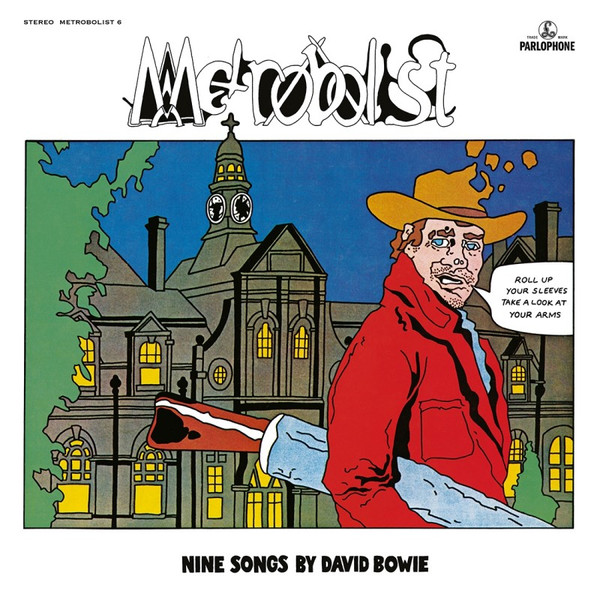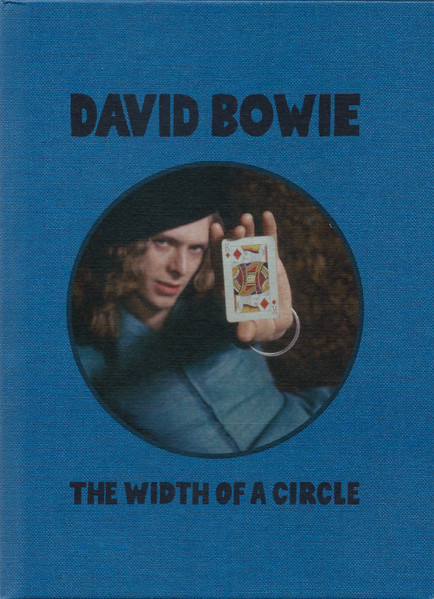Lyrically, the songs are also closer to more along the lines of trademark Bowie. “The Width Of A Circle” is another lengthy epic, but he’s discovered dynamics. It dallies with the bisexual image, but still has some great sections amidst the posturing. Much shorter but just as involved is “All The Madmen”, an acknowledgement of the mental issues in his genealogy, with great guitar lines and an infectious fade. “Black Country Rock” is a gentle tweaking of Marc Bolan’s new glam sound for T. Rex, providing a break before the spooky “After All” closes the side with sped-up voices and burbling Moog.
Side two is dominated by a trio of ugly songs. “Running Gun Blues” isn’t much more than a riff with a lyric about a soldier for hire in Southeast Asia, whereas “Savior Machine” tells of a “President Joe” who contracts the solution in the title, which of course is too smart to contain. “She Shook Me Cold” would be a metal parody if the genre existed yet; Ronno gets some Jimmy Page-style phrasing in his extended solo. The title track got more exposure thanks to several covers over the years, not least Nirvana’s unplugged rendition shortly before Kurt Cobain’s suicide, and it brings the album back to a better place. However, “The Supermen” would be done better in a stripped-down yet still electric rendition a year later; here it’s overblown with layered vocals where none are needed.
Today, people insist that The Man Who Sold The World is his first great album, but that’s only if you like side two. Half of it is very good, and just as with its predecessor, it shows the genetics of the style that would make Bowie a media sensation. He would do better next time out.
Also, like its predecessor, it’s had different covers depending on when and where it was released. Americans first got a cartoony sleeve commissioned by Bowie until he decided to pose in a dress in time for the British release. Then, when RCA reissued it along with Space Oddity, the sleeve above was used. Its initial Rykodisc reissue restored the “dress” version, and as part of its campaign, included sundry bonus tracks, which were later assigned to other album reissues once the rights reverted to Bowie.
The Man Who Sold The World resisted any kind of expanded anniversary approach until its fiftieth, when Tony Visconti remixed every track except “After All” for a “new” package titled Metrobolist, allegedly Bowie’s original album title, with restored pre-dress artwork to match. For the most part, the new mix merely expands the sound picture, making it seem less constricted and giving it more punch, mostly by pumping the volume of the lead guitar, drums, and his own bass. Some of Bowie’s Bolanisms over the fade of “Black Country Rock” are boosted in the mix, and the title track gains a count-in; any other eye-raising differences weren’t immediately apparent.
Nine months later, following the concept of the Conversation Piece set but not its path, the album got something of a unique expansion via a companion set. The Width Of A Circle collected various odd recordings from 1970 leading up to the album on two discs. The first is devoted to an appearance on John Peel’s BBC show, playing such favorite covers as “Amsterdam” and “Buzz The Fuzz” solo as well as songs with the newly formed band the Hype, with new discovery Ronson on guitar and Visconti on bass. Only six tunes from this appearance were on the Bowie At The Beeb, probably because they sounded better than the source for the others—Visconti’s own off-air copy—but context helps a lot here. The second disc begins with five songs from a stage show organized by Bowie’s mime mentor, likely recorded off the television broadcast. A remake of “When I Live My Dream” is accompanied by weedy organ in both its full version and reprise, “Columbine” and “Harlequin” are nice little sketches, but the vaudevillian “Threepenny Pierrot” merely reworks the melody of “London Bye, Ta-Ta”. Various singles from the year, including the first versions of “The Prettiest Star” and “Holy Holy” and another try at “London Bye, Ta-Ta”, appear in their original mixes as well as modern mixes, with another, more rockin’ Hype appearance on the BBC (only one of these songs was on the Beeb set) in between, likely for a less repetitive listening experience.
David Bowie The Man Who Sold The World (1970)—3
1990 Rykodisc: same as 1970, plus 4 extra tracks
David Bowie The Width Of A Circle (2021)—3
:format(jpeg):mode_rgb():quality(40)/discogs-images/R-6620945-1423406450-7647.jpeg.jpg)


i have found the man who sold the world at the library. the width of a circle is quite fun to fall into. i find it odd to think he put this out against the backdrop of the times and that 5 years later he was dueting with bing crosby. he really was a pulse.
ReplyDelete